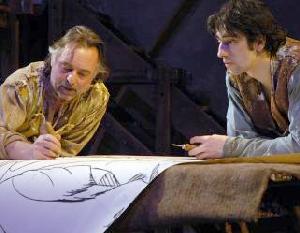SEARCH
REVIEWS
FEATURES
NEWS
Etcetera and
Short Term Listings
LISTINGS
Broadway
Off-Broadway
BOOKS and CDs
OTHER PLACES
Berkshires
London
LA/San Diego
Philadelphia
Elsewhere
QUOTES
On TKTS
LETTERS TO EDITOR
FILM
LINKS
MISCELLANEOUS
Free Updates
Masthead
Writing for us
A CurtainUp  London Review
London Review
 London Review
London ReviewOn the Ceiling
by Neil Dowden
|
We are flunkies to a Florentine fairy.
---- Lapo |

Ron Cook as Lapo and Ralf Little as Loti
(Photo: Hugo Glendinning) |
In what is basically a two-hander, the premise is that a couple of artisans, the master plasterer Lapo (Ron Cook) and his apprentice Loti (Ralf Little), provide the professional expertise which enables Michelangelo to put into practice his grand artistic ideas for painting the Sistine Chapel ceiling in the Vatican. (At that stage, Michelangelo was celebrated more as a sculptor than a painter.) These unsung heroes, apparently based on real people,- do all the graft while Michelangelo gains all the glory.
It's a nice conceit, a sideways look at the creation of one of the great masterpieces of Western art, from the point of view of the forgotten "little men" in the shadows of history -- a sort of Renaissance art equivalent of Rosencrantz and Guildenstern are Dead. But unlike Stoppard, Planer, in attempting to write a comedy with some serious thoughts behind it, falls between two stools. Despite some funny moments, this is not laugh-out-aloud stuff, and although the idea that art is often a collaborative process is pertinent, it's not enough to sustain a whole play.
The banter between the two craftsmen as they mix paints and wait for Michelangelo (whom they call "Millie" as they ridicule his camp pretentiousness, and who, Godot-like, never turns up), is pretty inconsequential. To misquote Eliot, "In the room the men come and go/Talking of Michelangelo."
There are allusions to famous people and events, such as Michelangelo's rival Raphael and the invasion of Italy by the French, but anything interesting happens off-stage. There is no dramatic tension in the play, so the evening just jogs along in a rather pedestrian way. The short scene after the interval, where Lapo and Lodi perform a comic song about how unfairly they've been treated, is simply a mistake. The closing scene with Pope Julius II -- who commissioned Michelangelo -- and a cardinal falls flat.
The rapport between the two workmen is well established in Jennie Darnell's production. Ron Cook's cynical but dedicated Lapo has the world-weary look of a man who knows he is never going to get the credit he deserves but is determined to do his job as well as he can. In contrast, for Ralf Little's young, na´ve and likeable Loti the priorities are getting plastered and getting laid rather than plastering and laying out frescoes.
Designer Matthew Wright's scaffolding set is highly effective, while Neil Austin's digital lighting effects at the end give some impression of the Sistine Chapel ceiling's grandeur -- but by then it is far too late for a play that remains firmly on the ground level.
|
ON THE CEILING
Written by Nigel Planer Directed by Jennie Darnell With: Ron Cook, Ralf Little, David Frederickson, Luke Healy Design: Matthew Wright Lighting: Neil Austin Sound: Fergus O'Hare Music: Adam Cork Running time: 2 hours including one interval A Birmingham Repertory Theatre Production Box Office: 0870890 1104 Booking until 31st December 2005 Reviewed by Neil Dowden based on 12th September performance at the Garrick Theatre, Charing Cross Road, London WC2 (Tube: Leicester Square) |





